Complete Classical Piano Music
- p.1 (Aa - Al)
- p.2 (Al - At)
- p.3 (At - Ba)
- p.4 (Ba - Ba)
- p.5 (Ba - Ba)
- p.6 (Ba - Ba)
- p.7 (Ba - Ba)
- p.8 (Ba - Ba)
- p.9 (Ba - Ba)
- p.10 (Ba - Ba)
- p.11 (Ba - Be)
- p.12 (Be - Be)
- p.13 (Be - Be)
- p.14 (Be - Be)
- p.15 (Be - Be)
- p.16 (Be - Be)
- p.17 (Be - Be)
- p.18 (Be - Bo)
- p.19 (Bo - Br)
- p.20 (Br - Br)
- p.21 (Br - Bu)
- p.22 (Bu - Ch)
- p.23 (Ch - Ch)
- p.24 (Ch - Ch)
- p.25 (Ch - Ch)
- p.26 (Ch - Ch)
- p.27 (Ch - Cl)
- p.28 (Cl - Co)
- p.29 (Co - Cz)
- p.30 (Cz - Da)
- p.31 (Da - De)
- p.32 (De - De)
- p.33 (De - De)
- p.34 (De - Du)
- p.35 (Du - En)
- p.36 (En - Fo)
- p.37 (Fr - Ge)
- p.38 (Gi - Gr)
- p.39 (Gr - Gr)
- p.40 (Gr - Gu)
- p.41 (Gu - Ha)
- p.42 (Ha - Ha)
- p.43 (Ha - Ha)
- p.44 (Ha - He)
- p.45 (He - Hy)
- p.46 (Ia - Jo)
- p.47 (Jo - Ka)
- p.48 (Ka - Ko)
- p.49 (Ko - La)
- p.50 (La - Li)
- p.51 (Li - Li)
- p.52 (Li - Li)
- p.53 (Li - Ma)
- p.54 (Ma - Mc)
- p.55 (Mc - Me)
- p.56 (Me - Mo)
- p.57 (Mo - Mo)
- p.58 (Mo - Mo)
- p.59 (Mo - Mo)
- p.60 (Mo - Na)
- p.61 (Ne - Pa)
- p.62 (Pa - Pl)
- p.63 (Pl - Pr)
- p.64 (Pr - Ra)
- p.65 (Ra - Ra)
- p.66 (Ra - Ra)
- p.67 (Ra - Ri)
- p.68 (Ri - Ro)
- p.69 (Ro - Sa)
- p.70 (Sa - Sc)
- p.71 (Sc - Sc)
- p.72 (Sc - Sc)
- p.73 (Sc - Sc)
- p.74 (Sc - Sc)
- p.75 (Sc - Sc)
- p.76 (Sc - Sc)
- p.77 (Sc - Sh)
- p.78 (Sh - Sn)
- p.79 (Sn - St)
- p.80 (St - Sz)
- p.81 (Ta - Tc)
- p.82 (Tc - Tu)
- p.83 (Tu - Va)
- p.84 (Va - Va)
- p.85 (Va - Va)
- p.86 (Va - Va)
- p.87 (Va - Va)
- p.88 (Va - Va)
- p.89 (Va - Va)
- p.90 (Va - Va)
- p.91 (Va - Va)
- p.92 (Va - Va)
- p.93 (Va - Va)
- p.94 (Va - Va)
- p.95 (Va - Va)
- p.96 (Va - Va)
- p.97 (Va - Vi)
- p.98 (Vi - We)
- p.99 (We - Za)
- p.100 (Za - Zy)
- Next >
-

-
Beethoven, Ludwig Van
Great Piano Works of
Category: Piano Composer Folios
Item: 027948
Grade:
Price: $9.95
Availability: Ships in 6 to 9 Days - View Shopping Cart
-

-
Beethoven, Ludwig Van
Great Sonatas (5) (Schenker)
Includes Sonata No 8 in Cm, op 13 "Pathetique"; Sonata No 14 in C#m, op 27/2 "Moonlight": Sonata No 21 in C, op 53 "Waldstein"; Sonata No 23 in Fm, op 57 "Appassionata"; and Sonata No 26 in Eb, op 81a "Les Adieux".
Category: Piano Composer Folios
Item: 034966
Grade:
Price: $14.95
Availability: Ships in 6 to 9 Days - View Shopping Cart
-

-
Beethoven, Ludwig Van
Greatest Sonatas, w/Audio (Stevens)
Includes Moonlight (No 14, op 27/2), Pathetique (op 13), Waldstein (op 53), Appsionata (op 57) and Les Adieux (op 81a) Sonatas.
Category: Piano Composer Folios
Item: 055484
Grade:
Price: $22.95
Availability: Ships in 10 to 15 Days - View Shopping Cart
-

-
Beethoven, Ludwig Van
I Can Play That (Duro)
A selection of 17 classical pieces from the great composer arranged for easy piano with chord symbols. Includes themes from the Moonlight Sonata, Pathetique Sonata and the Pastoral Symphony.
Category: Piano Composer Folios
Item: 018997
Grade:
Price: $9.95
Availability: Ships in 6 to 9 Days - View Shopping Cart
-

-
Beethoven, Ludwig Van
Introduction
Category: Piano Composer Folios
Item: 016711
Grade:
Price: $8.95
Availability: Ships in 6 to 9 Days - View Shopping Cart
-

-
Beethoven, Ludwig Van
Keyboard Classic w/Audio - 9 Pieces
Category: Piano Composer Folios
Item: 037982
Grade:
Price: $9.95
Availability: Ships in 6 to 9 Days - View Shopping Cart
-
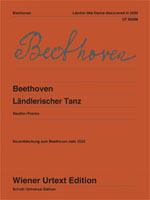
-
Beethoven, Ludwig Van
Landlerischer Tanzer (Reutter/Franke)
Romantic. A newly discovered, previously unpublished Beethoven work! During the research work for an edition of the Wiener Urtext Edition, its editor-in-chief, Dr. Jochen Reutter, examined a double page with sketches by Ludwig van Beethoven from the years 1790-1792 in the music collection of the Vienna Library in City Hall. At the very end of the fourth page, among the multitude of different sketches, a piano piece called Andante had been discovered some time ago. But the fact that a complete lit...
Read More
Category: Piano Solos
Item: 129226
Grade: Intermediate
Price: $4.50
Availability: Usually Ships in 24 Hours - View Shopping Cart
-

-
Beethoven, Ludwig Van
Library of Piano Works, v.4 w/Audio (Beattie)
Includes Bagatelles & Rondos.
Category: Piano Composer Folios
Item: 055494
Grade:
Price: $12.95
Availability: Ships in 6 to 9 Days - View Shopping Cart
-

-
Beethoven, Ludwig Van
Library, v.1 - Dances, Songs, Studies w/Audio (Beattie)
Category: Piano Composer Folios
Item: 041454
Grade:
Price: $12.95
Availability: Ships in 6 to 9 Days - View Shopping Cart
-

-
Beethoven, Ludwig Van
Library, v.2 - Dances & Bagatelles w/Audio (Beattie)
Category: Piano Composer Folios
Item: 041455
Grade:
Price: $12.95
Availability: Ships in 6 to 9 Days - View Shopping Cart
-

-
Beethoven, Ludwig Van
Little Known Pieces
Category: Piano Composer Folios
Item: 011685
Grade:
Price: $4.25
Availability: Ships in 6 to 9 Days - View Shopping Cart
-

-
Beethoven, Ludwig Van
Masterpieces
Category: Piano Composer Folios
Item: 053372
Grade:
Price: $12.95
Availability: Ships in 6 to 9 Days - View Shopping Cart
-

-
Beethoven, Ludwig Van
Masterpieces of Piano
Category: Piano Composer Folios
Item: 014521
Grade:
Price: $11.95
Availability: Ships in 6 to 9 Days - View Shopping Cart
-

-
Beethoven, Ludwig Van
Minuet in G
Category: Piano Solos
Item: 011682
Grade:
Price: $3.95
Availability: Ships in 6 to 9 Days - View Shopping Cart
-

-
Beethoven, Ludwig Van
Minuet in G (Palmer)
Category: Piano Solos
Item: 001872
Grade:
Price: $2.50
Availability: Ships in 6 to 9 Days - View Shopping Cart
-

-
Beethoven, Ludwig Van
Moonlight Sonata, op 27, no 1 - 1st movement (McLean)
Category: Piano Solos
Item: 046964
Grade: Elementary
Price: $2.95
Availability: Ships in 10 to 15 Days - View Shopping Cart
-
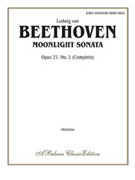
-
Beethoven, Ludwig Van
Moonlight Sonata, op 27, no 2
Category: Piano Solos
Item: 107220
Grade:
Price: $7.99
Availability: Ships in 10 to 15 Days - View Shopping Cart
-

-
Beethoven, Ludwig Van
Moonlight Sonata, op 27, no 2 (Harding)
Category: Piano Solos
Item: 001889
Grade:
Price: $2.50
Availability: Ships in 10 to 14 Days - View Shopping Cart
-

-
Beethoven, Ludwig Van
Moonlight Sonata, op 27, no 2 (Levine)
Category: Piano Solos
Item: 001890
Grade:
Price: $1.95
Availability: Ships in 10 to 14 Days - View Shopping Cart
-

-
Beethoven, Ludwig Van
Moonlight Sonata, op 27, no 2 - 1st movement (Clarfield)
Artistic Preparation and Performance Series.
Category: Piano Solos
Item: 034323
Grade:
Price: $6.95
Availability: Ships in 6 to 9 Days - View Shopping Cart
-
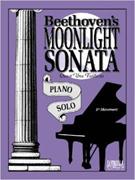
-
Beethoven, Ludwig Van
Moonlight Sonata, op 27, no 2 - 1st movement (Robbins)
Category: Piano Solos
Item: 102043
Grade: Intermediate
Price: $4.95
Availability: Ships in 10 to 15 Days - View Shopping Cart
-

-
Beethoven, Ludwig Van
Moonlight Sonata, op 27, no 2 - 1st movement (McLean)
Newly engraved and edited, this classic first movement from Beethoven's Sonata Opus 27, No. 2 is presented here as part of the FJH Piano Solo Series. - the publisher
Category: Piano Solos
Item: 071695
Grade:
Price: $5.95
Availability: Usually Ships in 24 Hours - View Shopping Cart
-
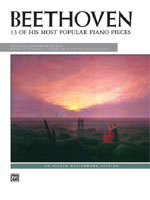
-
Beethoven, Ludwig Van
Most Popular Pieces (13)
Full title is "13 of His Most Popular Piano Pieces." Includes: Bagatelle in A Minor, Op. 119, No. 9; Bagatelle in G Minor, Op. 119, No. 1; Contradance ,WoO 14, No. 1; Fr Elise ,WoO 59; Menuet in G Major, WoO 10, No. 2; Six Variations on a Swiss Folk Song ,WoO 64; Six Variations on the Duet "Nel Cor Pi Non Mi Sento" ,WoO 70; Sonata in G ,Op. 49, No. 2; Sonata No. 8 (2nd Movement) ,Op. 13; Sonata Quasi una Fantasia (1st Movement) ,Op. 27, No. 2; Sonatina in F ,Anh. 5, No. 2; Theme from Rondo a C...
Read More
Category: Piano Composer Folios
Item: 016730
Grade:
Price: $10.99
Availability: Ships in 6 to 9 Days - View Shopping Cart
-
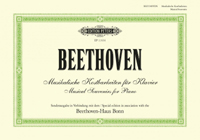
-
Beethoven, Ludwig Van
Musical Souvenirs
Specially produced in association with the Beethoven-Haus Bonn for the 250th Anniversary of Ludwig van Beethoven's birth, this souvenir collection of some of his most famous pieces and movements allows us to rediscover the joy of experiencing the full range of his music in the home and through our fingers, just as millions of amateur musicians got to know and love this music in the days before recordings. The volume contains original works for piano, such as the ever-popular Fr Elise, and expert...
Read More
Category: Piano Composer Folios
Item: 132452
Grade:
Price: $16.95
Availability: Ships in 10 to 15 Days - View Shopping Cart
-

-
Beethoven, Ludwig Van
Ode to Joy
Category: Piano Solos
Item: 003050
Grade:
Price: $3.50
Availability: Ships in 6 to 9 Days - View Shopping Cart
-

-
Beethoven, Ludwig Van
Ode to Joy - Theme from Symphony No 9 (Robbins)
Originally written as a chorale, this Beethoven classic, Ode To Joy was the musical theme of the 1998 Summer Olympics. The live global performance conducted by Seiji Ozawa included a 2,000 member chorus in each of five continents. This well known classictheme is performed at a variety of events including weddings, holiday concerts and church services to name a few. - the publisher
Category: Piano Solos
Item: 137958
Grade: Intermediate
Price: $4.95
Availability: Usually Ships in 24 Hours - View Shopping Cart
-
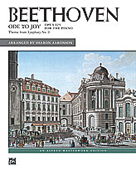
-
Beethoven, Ludwig Van
Ode to Joy, from Symphony No 9 (Aaronson)
This nicely filled-out arrangement of the famous theme from Beethoven's 9th Symphony is appropriate as a performance piece for an intermediate level pianist, featuring elements of the symphonic work intertwined with the theme. It is presented in D major,has a wide keyboard range, and nice extremes in dynamics. -the publisher
Category: Piano Composer Folios
Item: 027930
Grade:
Price: $2.95
Availability: Ships in 6 to 9 Days - View Shopping Cart
-
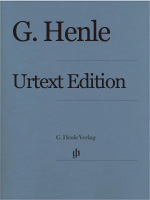
-
Beethoven, Ludwig Van
Piano Pieces [Klavierstuecke] (Irmer)
G. Henle URTEXT edition. This inexhaustible collection of Beethoven's piano works is highly recommended to players who wish to gain deepr insight into Beethoven's musical development. It contains all of Beethoven's piano compositions except for the 32 sonatas, the variations and the dances, and thus presents works from all stages of this great composer's life. Included are his endearing Bagatelles op. 33, the album leaf "Fr Elise," "The Rage over a Lost Penny," and the three "Kurfrsten" Sonatas...
Read More
Category: Piano Composer Folios
Item: 001874
Grade:
Price: $44.95
Availability: Ships in 6 to 9 Days - View Shopping Cart
-
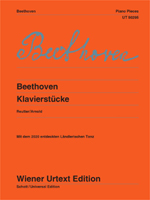
-
Beethoven, Ludwig Van
Piano Pieces [Klavierstuecke] (Reutter/Arnold)
Romantic. Ludwig van Beethoven has left a considerable number of individual pieces for piano in addition to sonatas and works of variations. They range from larger works such as "The Rage over the Lost Penny" or the Fantasia Op. 77 to the ingenious miniatures of the Bagatelles. In terms of their origin and history, they run through the entire ouvre of the composer from his time in Bonn to the last years of his life. The new edition completes the previous selection with important works, e.g. the R...
Read More
Category: Piano Composer Folios
Item: 133124
Grade:
Price: $35.50
Availability: Ships in 6 to 9 Days - View Shopping Cart
-

-
Beethoven, Ludwig Van
Piano Solos - Selected Works (Tucker)
Category: Piano Composer Folios
Item: 035284
Grade:
Price: $4.95
Availability: Ships in 6 to 9 Days - View Shopping Cart
-
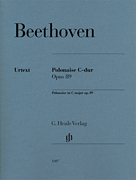
-
Beethoven, Ludwig Van
Polonaise in C, op 89 (Irmer)
Category: Piano Solos
Item: 112400
Grade:
Price: $8.95
Availability: Usually Ships in 24 Hours - View Shopping Cart
-
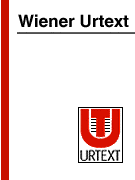
-
Beethoven, Ludwig Van
Rage Over a Lost Penny, op 129 [Alla Ingharese]
Thanks to its programmatic subtitle, 'The Rage over a Lost Penny', which was not by the composer, Beethoven's Rondo 'Alla ingharese quasi un Capriccio' became one of his most famous piano pieces. Beethoven's albeit not entirely complete autograph of the work from around 1795 has survived. It is the main source of the new edition; the first edition, published posthumously by Diabelli, provided a reasonably plausible orientation for missing parts in the original manuscript. In a few problematic c...
Read More
Category: Piano Solos
Item: 134945
Grade: Grade 5 - Early Advanced
Price: $9.95
Availability: Usually Ships in 24 Hours - View Shopping Cart
-

-
Beethoven, Ludwig Van
Rage Over a Lost Penny, op 129 [Alla Ingharese] (Biermann/Zhang)
This rondo for piano was composed in 1794/95 and has become known primarily by its sobriquet "The rage over the lost penny". However, this did not originate with the composer himself, but rather added to the autograph later by another hand. In his own original title, Beethoven emphasised its "Hungarian" style, though he wrote "Ingharese" instead of "allungharese," thereby emphasising the humorous nature of this spirited piece. Robert Schumann aptly remarked that "There can hardly be anything more...
Read More
Category: Piano Solos
Item: 135858
Grade: Advanced
Price: $9.95
Availability: Ships in 10 to 15 Days - View Shopping Cart
-

-
Beethoven, Ludwig Van
Rage Over a Lost Penny, op 129 [Alla Ingharese]
G. Henle URTEXT edition of Alla Ingharese quasi un Capriccio [Rage over the last penny].
Category: Piano Solos
Item: 013817
Grade:
Price: $8.95
Availability: Ships in 6 to 9 Days - View Shopping Cart
-

-
Beethoven, Ludwig Van
Rondo a Capriccio, op 129
Category: Piano Solos
Item: 008717
Grade:
Price: $3.50
Availability: Ships in 6 to 9 Days - View Shopping Cart
-

-
Beethoven, Ludwig Van
Rondo a Capriccio, op 129
Category: Piano Solos
Item: 011683
Grade:
Price: $3.50
Availability: Ships in 6 to 9 Days - View Shopping Cart
-

-
Beethoven, Ludwig Van
Rondo a Capriccio, op 129
Category: Piano Solos
Item: 008670
Grade:
Price: $2.50
Availability: Ships in 6 to 9 Days - View Shopping Cart
-

-
Beethoven, Ludwig Van
Rondo in Bb, Woo 6 (Kuethen/Umbreit/Groethuysen)
Category: Piano Solos
Item: 094252
Grade:
Price: $24.95
Availability: Ships in 6 to 9 Days - View Shopping Cart
-

-
Beethoven, Ludwig Van
Rondo in C, op 51
G. Henle URTEXT edition
Category: Piano Solos
Item: 013810
Grade:
Price: $8.95
Availability: Ships in 6 to 9 Days - View Shopping Cart
-
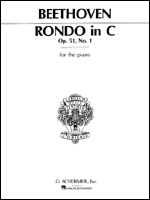
-
Beethoven, Ludwig Van
Rondo in C, op 51, no 1
Category: Piano Solos
Item: 133533
Grade:
Price: $3.95
Availability: Usually Ships in 24 Hours - View Shopping Cart
-
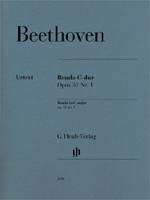
-
Beethoven, Ludwig Van
Rondo in C, op 51, no 1 (Biermann)
The two Rondos op. 51 were written independently of one another and only later consolidated into a single opus by Beethoven's publisher. The first of these works from 1797 quickly became popular on account of how it combines simple, catchy melody with surprising modulations and expressive, dramatic eruptions within a compact form. With its moderate degree of difficulty, the piece is ideal preparation before embarking on Beethoven's piano sonatas. Based on her preliminary research for the critical...
Read More
Category: Piano Solos
Item: 129367
Grade:
Price: $9.95
Availability: Usually Ships in 24 Hours - View Shopping Cart
-
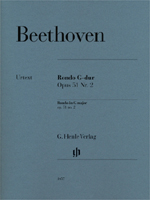
-
Beethoven, Ludwig Van
Rondo in G, op 51, no 2 (Biermann)
This composition published in 1802 constitutes a completely separate concert piece from Opus 51 no. 1. Compared to the first Rondo (op. 51 no. 1), the second is considerably longer and with a markedly different expressive disposition. Here, lyrical traits predominate without any of the dramatic incursions otherwise so emblematic of Beethoven's compositions. For that reason, this comparatively reserved work did not enjoy the same popularity as the Rondo op. 51 no. 1 and continues to invite redisco...
Read More
Category: Piano Solos
Item: 129266
Grade:
Price: $10.95
Availability: Usually Ships in 24 Hours - View Shopping Cart
-

-
Beethoven, Ludwig Van
Selected Easy Sonata Movements, v.2
Category: Piano Composer Folios
Item: 011944
Grade:
Price: $8.95
Availability: Ships in 6 to 9 Days - View Shopping Cart
-
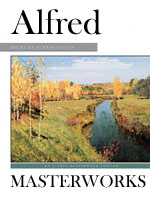
-
Beethoven, Ludwig Van
Selected Int-Early Advanced Sonata Movements (Hinson)
Category: Piano Composer Folios
Item: 011942
Grade:
Price: $9.95
Availability: Ships in 6 to 9 Days - View Shopping Cart
-

-
Beethoven, Ludwig Van
Selected Works (Snell)
Category: Piano Composer Folios
Item: 016358
Grade:
Price: $5.50
Availability: Ships in 10 to 14 Days - View Shopping Cart
-
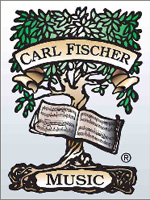
-
Beethoven, Ludwig Van
Short Pieces (Blickenstaff)
Category: Piano Composer Folios
Item: 029241
Grade:
Price: $7.95
Availability: Ships in 6 to 9 Days - View Shopping Cart
-
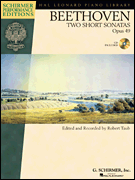
-
Beethoven, Ludwig Van
Short Sonatas (2), op 49, nrs 1 & 2 w/Audio (Taub)
Category: Piano Composer Folios
Item: 079858
Grade:
Price: $8.95
Availability: Ships in 6 to 9 Days - View Shopping Cart
-

-
Beethoven, Ludwig Van
Simply Beethoven - 27 Timeless Masterpieces (Ray)
Category: Piano Composer Folios
Item: 067729
Grade: Elementary
Price: $13.99
Availability: Ships in 6 to 9 Days - View Shopping Cart
-

-
Beethoven, Ludwig Van
Sonata in Eb, woo 47, no 1 (Cooper)
Category: Piano Solos
Item: 096359
Grade:
Price: $10.25
Availability: Usually Ships in 24 Hours - View Shopping Cart
-
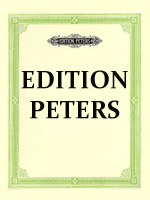
-
Beethoven, Ludwig Van
Sonata No 1 in Fm, op 2, no 1 (Cooper/Ward)
Category: Piano Solos
Item: 079460
Grade:
Price: $9.95
Availability: Ships in 10 to 15 Days - View Shopping Cart
- p.1 (Aa - Al)
- p.2 (Al - At)
- p.3 (At - Ba)
- p.4 (Ba - Ba)
- p.5 (Ba - Ba)
- p.6 (Ba - Ba)
- p.7 (Ba - Ba)
- p.8 (Ba - Ba)
- p.9 (Ba - Ba)
- p.10 (Ba - Ba)
- p.11 (Ba - Be)
- p.12 (Be - Be)
- p.13 (Be - Be)
- p.14 (Be - Be)
- p.15 (Be - Be)
- p.16 (Be - Be)
- p.17 (Be - Be)
- p.18 (Be - Bo)
- p.19 (Bo - Br)
- p.20 (Br - Br)
- p.21 (Br - Bu)
- p.22 (Bu - Ch)
- p.23 (Ch - Ch)
- p.24 (Ch - Ch)
- p.25 (Ch - Ch)
- p.26 (Ch - Ch)
- p.27 (Ch - Cl)
- p.28 (Cl - Co)
- p.29 (Co - Cz)
- p.30 (Cz - Da)
- p.31 (Da - De)
- p.32 (De - De)
- p.33 (De - De)
- p.34 (De - Du)
- p.35 (Du - En)
- p.36 (En - Fo)
- p.37 (Fr - Ge)
- p.38 (Gi - Gr)
- p.39 (Gr - Gr)
- p.40 (Gr - Gu)
- p.41 (Gu - Ha)
- p.42 (Ha - Ha)
- p.43 (Ha - Ha)
- p.44 (Ha - He)
- p.45 (He - Hy)
- p.46 (Ia - Jo)
- p.47 (Jo - Ka)
- p.48 (Ka - Ko)
- p.49 (Ko - La)
- p.50 (La - Li)
- p.51 (Li - Li)
- p.52 (Li - Li)
- p.53 (Li - Ma)
- p.54 (Ma - Mc)
- p.55 (Mc - Me)
- p.56 (Me - Mo)
- p.57 (Mo - Mo)
- p.58 (Mo - Mo)
- p.59 (Mo - Mo)
- p.60 (Mo - Na)
- p.61 (Ne - Pa)
- p.62 (Pa - Pl)
- p.63 (Pl - Pr)
- p.64 (Pr - Ra)
- p.65 (Ra - Ra)
- p.66 (Ra - Ra)
- p.67 (Ra - Ri)
- p.68 (Ri - Ro)
- p.69 (Ro - Sa)
- p.70 (Sa - Sc)
- p.71 (Sc - Sc)
- p.72 (Sc - Sc)
- p.73 (Sc - Sc)
- p.74 (Sc - Sc)
- p.75 (Sc - Sc)
- p.76 (Sc - Sc)
- p.77 (Sc - Sh)
- p.78 (Sh - Sn)
- p.79 (Sn - St)
- p.80 (St - Sz)
- p.81 (Ta - Tc)
- p.82 (Tc - Tu)
- p.83 (Tu - Va)
- p.84 (Va - Va)
- p.85 (Va - Va)
- p.86 (Va - Va)
- p.87 (Va - Va)
- p.88 (Va - Va)
- p.89 (Va - Va)
- p.90 (Va - Va)
- p.91 (Va - Va)
- p.92 (Va - Va)
- p.93 (Va - Va)
- p.94 (Va - Va)
- p.95 (Va - Va)
- p.96 (Va - Va)
- p.97 (Va - Vi)
- p.98 (Vi - We)
- p.99 (We - Za)
- p.100 (Za - Zy)
- Next >
More Options
- Use our Custom Order Page to special order items you can't find.
- Use our Catalog Order Page to order items from a printed catalog, or if you already know our catalog number for the item(s) you're interested in.
- And as always, feel free to E-mail us with your questions!
